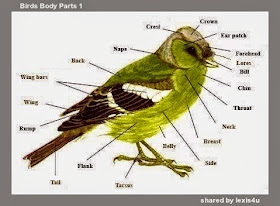Thematic Vocabulary Unit Nº051 v.06
Main Bird Definition and Features
- bird |n| a warm blooded egg-laying vertebrate animal of a class distinguished by the possession of feathers, wings, and a beak, typically able to fly.
- "A large bird flew overhead."
- "The birds were singing outside our window."
- vertebrate |n| any chordate animal of the subphylum Vertebrata, characterized by a bony or cartilaginous skeleton and a well-developed brain: the group contains fishes, amphibians, reptiles, birds, and mammals.
Kinds of Birds
- aquatic bird |n| wading and swimming and diving birds of either fresh or salt water .
- birds of prey / raptors / raptorial birds |n| any of numerous predacious, flesh-eating birds, as the eagles, hawks, kites, vultures, falcons, and owls, having a sharp, downwardly curved beak, talons, and, usually, soaring flight.
- flyghtless birds / ratites / ratite birds |n| the flightless birds are birds that cannot fly. Two key differences between flying and flightless birds are the smaller wing bones of flightless birds and the absent (or greatly reduced) keel on their breastbone. (the keel anchors muscles needed for wing movement) Flightless birds also have more feathers than flying birds.
- carinate / carinate bird / flying bird |n| birds having keeled breastbones for attachment of flight muscles.
- migratory birds / bird of passage |n| migratory birds have the perfect morphology and physiology that enables them to fly fast and across long distances. However, their journey is often an exhausting one during which they go to their limits. The Red Knot for example, a 24 cm long wader weighing of around 220 g, breeds in Siberia and overwinters on the west coast of Africa, some even going down to South Africa. During its migration it loses nearly half of its body weight. Migratory birds therefore rarely fly to their destination non-stop but interrupt their journey frequently to rest and feed, or to sit out a spell of bad weather. Exactly how migrating birds find their flyways is not fully understood. Recent experiments indicate that they orientate along the Earth's magnetic field via special light receptors located in their eyes.
- nester |n| a bird that has built (or is building) a nest.
- night bird |n| any bird associated with night: owl; nightingale; nighthawk; etc.
- seabird / sea bird / marine birds |n| birds, such as a petrel or albatross, that frequents the ocean, especially far from shore.
- wader bird |n| any of many long-legged birds that wade in water in search of food.
Birds Body Parts
- air sac |n| any of the membranous air-filled extensions of the lungs of birds.
- beak |n| a bird's horny projecting jaws, a bill.
- claw |n| a curved, pointed horny nail on each digit of the foot in birds.
- crest |n| a usually ornamental tuft, ridge, or similar projection on the head of a bird or other animal.
- feather / feathers / plume / plumage |n| the light horny waterproof structure forming the external covering of birds.
- preen gland / uropygial gland |n| oil-secreting gland situated at the base of the tail in most birds.
- syrinx |n| the vocal organ of a bird, which is situated in the lower part of the trachea.
- tail |n| the hindmost part of an animal, especially when extended beyond the rest of the body, such as the flexible extension of the backbone in a vertebrate or the feathers at the hind end of a bird.
- uropygium |n| posterior part of a bird's body from which the tail feathers grow.
- wings |n| a modified forelimb or other appendage enabling a bird to fly.
- furcula |n| a forked bone formed by the fusion of the clavicles of most birds.
More Related to Birds
- bevy |n| a flock of birds (especially when gathered close together on the ground)
- "We were visited at breakfast by a bevy exited ducks."
- flock |n| a number of birds moving or resting together.
- "These birds fly in huge flocks."
- "A flock of birds passed overhead."
- flock of birds |n| a group of birds flying together.
- "We watched a flock of birds fly over the field."
- migration |n| the periodic passage of groups of animals (especially birds or fishes) from one region to another for feeding or breeding.
- avian migration |n| the avian migration is a natural process, whereby different birds fly over distances of hundreds and thousands of kilometres in order to find the best ecological conditions and habitats for feeding, breeding and raising their young. When the conditions at breeding sites become unfavourable due to low temperatures, migratory birds fly to regions where conditions are better.
- "Most birds have to fly long distances to migrate."
- "The seasonal migration of birds."
- egg |n| an oval or round object laid by a female bird, reptile, fish, or invertebrate and containing an ovum which if fertilized can develop into a new organism.
- nest |n| a structure in which animals lay eggs or give birth to their young.
- "Birds are nesting outside my window every Spring."
- "Cuckoos are famous for laying their eggs in the nest of other birds."
- "Young eagles leave the nest after only two months."
Visual Gallery


More Posts Related
- Animals in General
- Animals (visual)
- Mammals
- Mammals (visual)
- Insects
- Insects (visual)
- Sea Animals (visual)
.jpg)








.jpg)
No comments:
Post a Comment